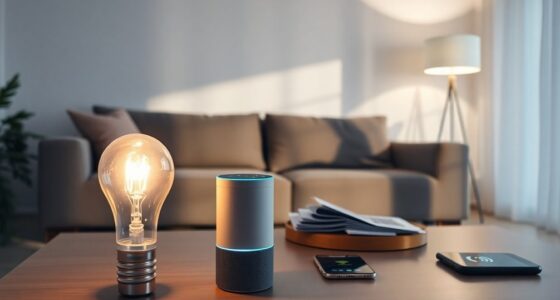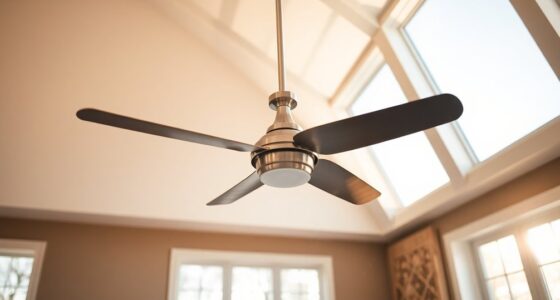When choosing smart light bulbs, consider the type you need, like dimming, color-changing, or smart LEDs. Focus on energy efficiency, as smart bulbs use considerably less power and last longer than traditional ones. Check for compatibility with your existing smart home system and envision how you’d like to automate your lighting. Setting a budget can help narrow down options without overspending. If you want to maximize your lighting experience further, there’s more to explore.
Key Takeaways
- Determine the type of smart bulb you need, such as dimming, temperature-changing, or color-changing, based on your lighting preferences.
- Ensure compatibility with existing smart home systems and check for necessary hubs or Wi-Fi connectivity.
- Assess energy efficiency and lifespan to save on energy costs and replacement expenses over time.
- Set a budget that aligns with your needs, exploring both affordable and premium brands for smart bulbs.
- Consider advanced features like automation, voice control, and customizable settings to enhance your smart lighting experience.
Understanding Different Types of Smart Light Bulbs
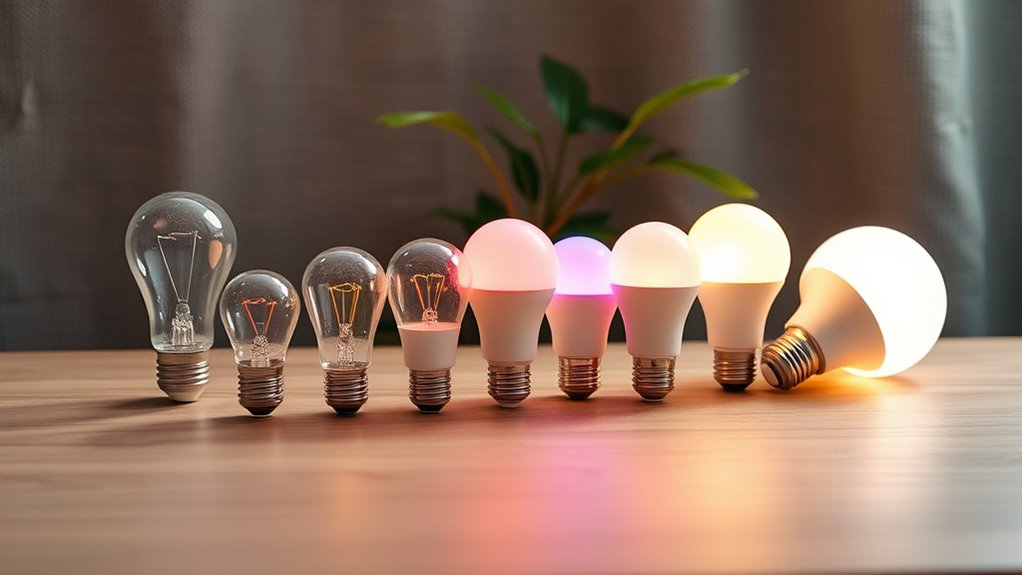
When it comes to smart light bulbs, understanding the different types available can help you choose the right fit for your needs.
Dimming smart bulbs let you adjust light intensity, creating the perfect mood for any occasion. Temperature-changing bulbs allow you to shift between warm and cool hues, enhancing both ambiance and task lighting. Additionally, color accuracy in lighting can significantly enhance the overall aesthetic of your space. Many smart bulbs are designed with energy-efficient technology that reduces electricity usage without sacrificing performance. Investing in energy-efficient solutions can also lower your overall utility bills. Furthermore, smart bulbs are often equipped with advanced features that allow for seamless integration with home automation systems.
Adjust light intensity with dimming smart bulbs for the perfect mood, or switch between warm and cool hues with temperature-changing bulbs.
If you’re after aesthetics, color-changing bulbs offer a vibrant palette for your space. Smart LED bulbs are energy-efficient and come in various shapes, like A19 for lamps or BR30 for recessed lighting.
For unique installations, consider smart strip lights or downlights, which provide flexibility in design. Knowing these options makes it easier to select the ideal bulbs for your home. Additionally, solar lighting options can enhance your outdoor spaces sustainably.
Energy Efficiency and Cost Savings

As you explore the benefits of smart light bulbs, energy efficiency and cost savings emerge as key factors in your decision.
Smart LED bulbs use around 10 watts compared to 60 watts for incandescent bulbs, saving you about 83% in energy consumption. Despite their lower wattage, they produce similar or even higher brightness levels. Additionally, the use of renewable energy sources can further enhance the environmental benefits of your smart lighting choices. By integrating solar energy solutions, you can further reduce your carbon footprint while enjoying the advantages of smart lighting. Moreover, utilizing energy-efficient heat pumps in conjunction with smart lighting can lead to even greater overall energy savings in your home. Furthermore, the adoption of geothermal energy can significantly boost the efficiency of your home’s heating and cooling systems.
Over time, this energy efficiency translates to significant reductions in your monthly electricity bills. While the upfront cost of smart LEDs may be higher, their longevity—lasting up to 25,000 hours—means lower replacement costs.
If every U.S. household switched to ENERGY STAR certified LEDs, we could save nearly $5 billion in energy costs annually, making smart bulbs a wise investment for both your wallet and the environment. Additionally, using energy-efficient lighting can further support a healthier lifestyle by promoting cleanliness and hygiene in your home.
Exploring Smart Features
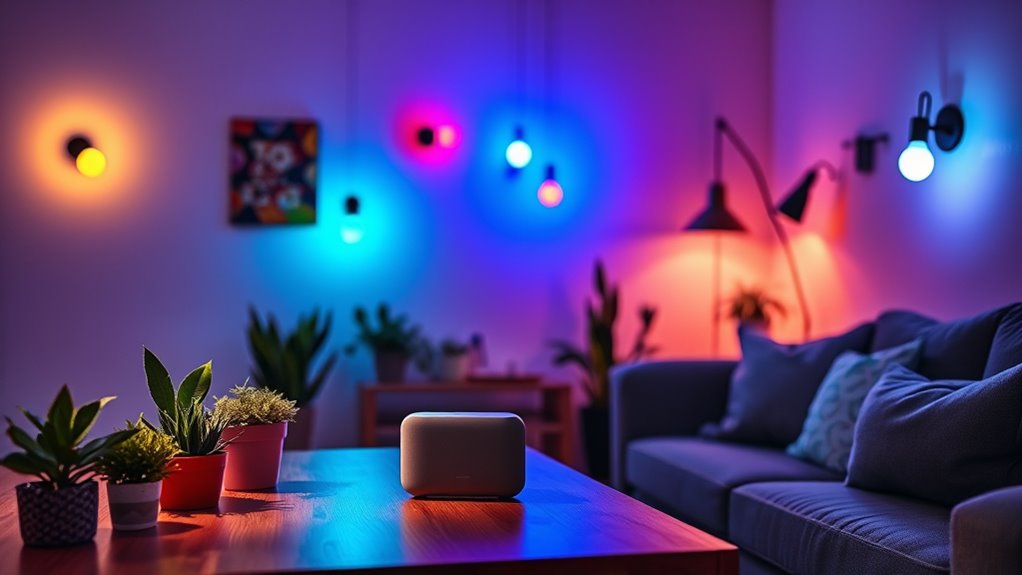
Smart light bulbs offer an array of advanced features that enhance your home experience, making them more than just a source of illumination. You can automate lighting schedules to improve ambiance and boost security, while custom scene creation lets you personalize your space for any occasion. Furthermore, many users find that integrating these bulbs can lead to improved energy efficiency in their homes. Additionally, adopting mobile responsiveness in your smart home devices can enhance their usability and flexibility.
These bulbs integrate seamlessly with platforms like Apple Home and Google Home, and they support voice assistants like Alexa and Google Assistant for hands-free control. You’ll appreciate the extensive customization options, enabling you to tailor lighting effects and routines to your preferences. With these smart features, your lighting can adapt to your lifestyle, making your home both functional and inviting. Embrace the convenience and versatility that smart bulbs bring to your living environment. Furthermore, these smart devices can be part of a larger trend towards home automation, enhancing your overall living experience. Additionally, consider exploring best lifestyle products that can further enhance your daily routines. Additionally, many of these smart technologies are designed to work together, creating a cohesive and efficient home environment.
Compatibility and Installation Considerations
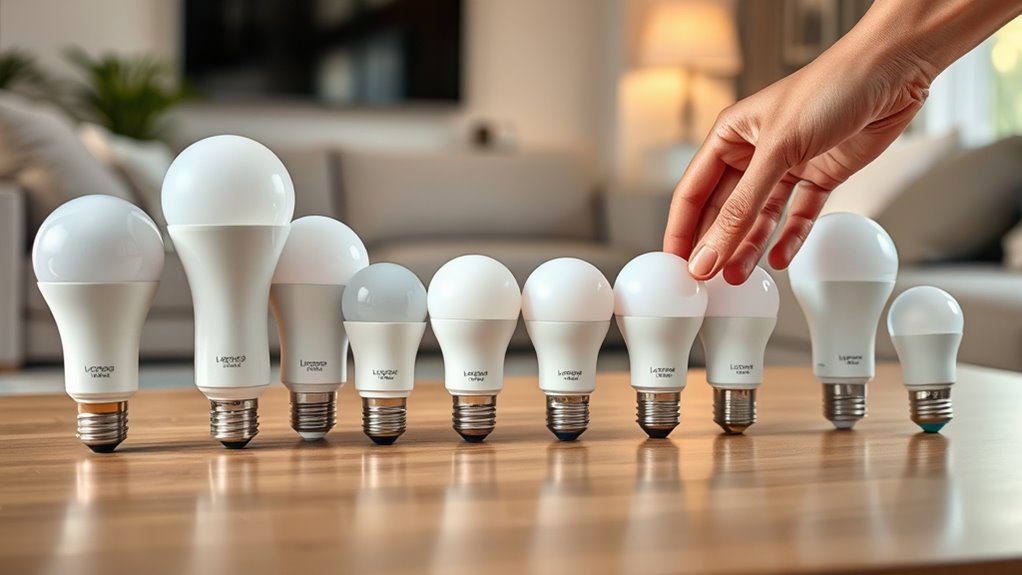
Choosing the right smart light bulbs involves understanding compatibility and installation considerations to confirm they fit seamlessly into your home.
First, check if the bulbs work with your existing smart home systems like Google Home or Alexa. You’ll want bulbs that support voice control and integrate smoothly with other smart devices.
Also, consider whether a hub is necessary for connectivity or if the bulbs connect directly to Wi-Fi. Pay attention to socket types, wattage, and size to verify they match your fixtures.
For easy setup, select bulbs that require simple installation and offer clear pairing instructions.
Finally, make sure your home network can handle the smart bulbs’ connectivity needs for a hassle-free experience. Additionally, consider incorporating smart technology integration to enhance your lighting experience further.
Choosing the Right Design and Application
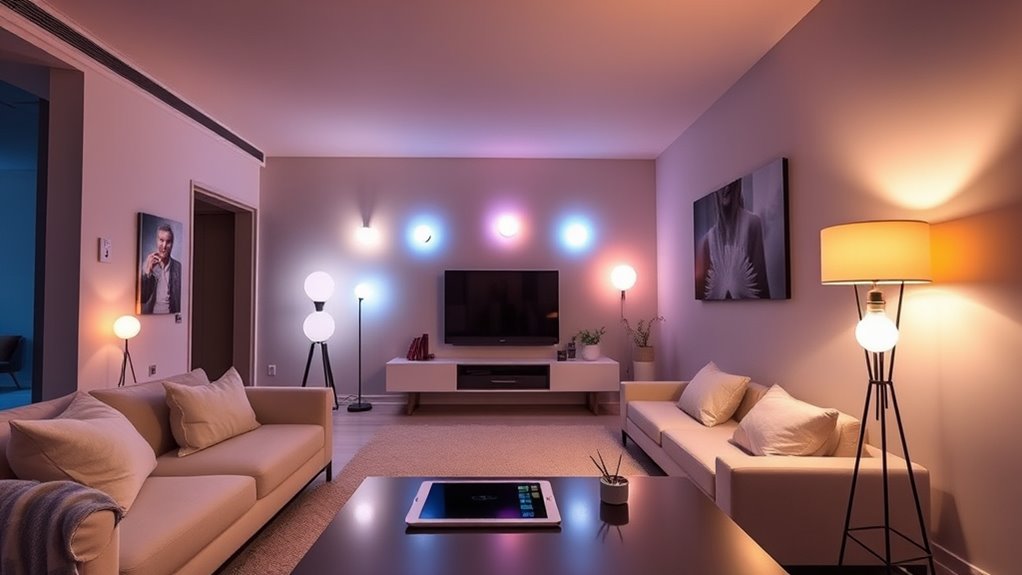
When selecting light bulbs for your home, it’s essential to reflect on both design and application to guarantee they meet your specific needs.
Consider energy-efficient LED bulbs, which come in various shapes and sizes, allowing for tailored aesthetics. Their thermal management features enhance longevity, ensuring they last longer. Additionally, energy-efficient models can significantly reduce your overall energy consumption, making them a smart choice for sustainability. Air purifiers can also improve indoor air quality, complementing the ambiance created by your lighting. Furthermore, using low light office plants in your space can add a natural touch while benefiting from the improved lighting. Incorporating sustainable materials into your light fixtures can further enhance your commitment to eco-friendly living.
For application, think about your spaces: use smart bulbs for ambient lighting to set the mood, or opt for focused task lighting for reading. If you’re planning outdoor lighting, smart bulbs offer remote control and scheduling options.
Additionally, explore automation features that integrate with other smart devices, creating customized scenes for different occasions. Keeping in mind the importance of proper sealing mechanisms, you can enhance your overall energy efficiency by ensuring your fixtures are well-designed to minimize heat loss.
With thoughtful design and application choices, you can elevate your home’s lighting experience.
Evaluating Cost and Value
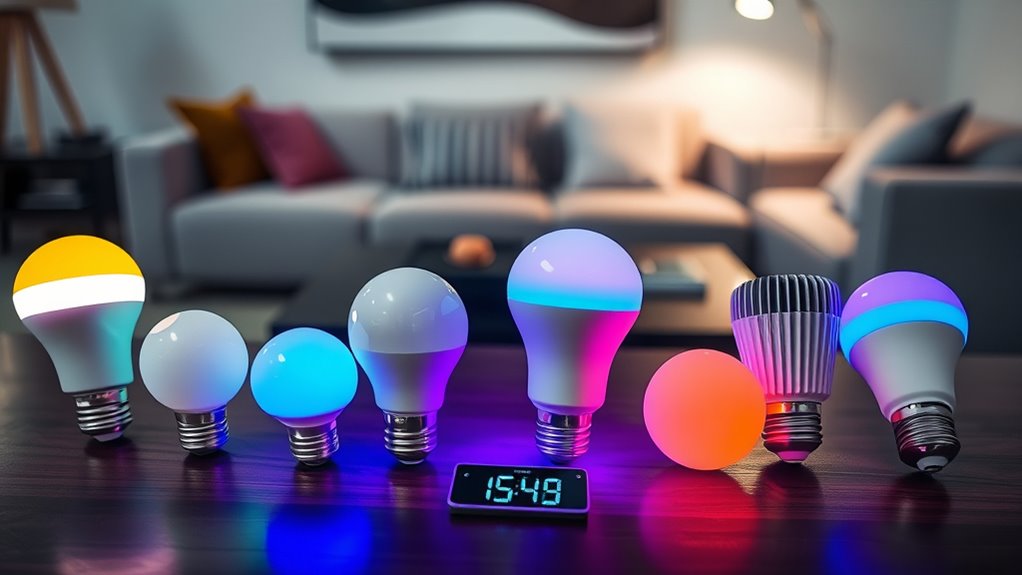
Evaluating the cost and value of smart light bulbs is essential for making an informed purchase. On average, these bulbs run about $42 each, but prices can range from $2.24 to $90.35, depending on features and brands. Creating a retirement savings plan is crucial to ensure you have the financial means to invest in smart home technology. Investing in alternative investments can also help diversify your portfolio, providing additional financial security for such purchases.
Setting a budget helps you balance costs with necessary features, ensuring you choose bulbs that meet your needs without overspending. Consider shopping during sales events like Black Friday for significant savings.
Brands like Wyze and Sengled offer affordable options with great features, while premium brands like Philips Hue provide high-quality, but pricier, color-changing bulbs. Additionally, exploring discount appliance retailers can help you find competitive pricing on other smart home devices.
Tips for Maximizing Your Smart Lighting Experience
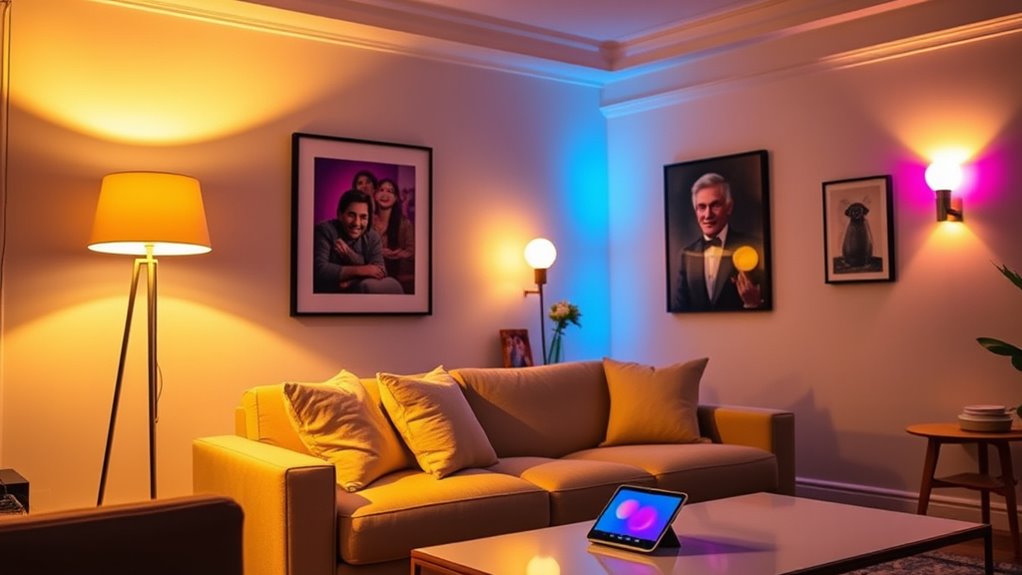
To truly enhance your smart lighting experience, it’s crucial to explore various features that can simplify your life and improve efficiency.
Start by integrating your smart bulbs with existing home systems for seamless control. Utilize automated scheduling and voice commands to manage your lights hands-free.
Take advantage of advanced occupancy sensors that adjust lighting based on movement, saving energy. Customize brightness and color to suit your mood or activity, and consider natural light utilization for added efficiency.
Monitor energy use through dedicated apps to stay informed. Finally, verify your smart lights have compatibility certifications, so they work well with other devices, maximizing convenience and functionality in your home.
Frequently Asked Questions
Can Smart Bulbs Work Without an Internet Connection?
Yes, smart bulbs can work without an internet connection.
You can use options like Bluetooth-enabled bulbs that connect directly to your smartphone, or Zigbee bulbs that create a mesh network for control.
These offline options offer reliable performance, enhanced privacy, and energy efficiency.
However, keep in mind that some advanced features mightn’t be available without the internet, and you may face compatibility issues with other smart devices.
Do Smart Bulbs Emit UV Light?
You might be surprised to learn that some smart bulbs do emit UV light, though usually in minimal amounts.
If you’re using LED bulbs, you’re in luck—these typically emit negligible UV radiation.
On the other hand, CFLs can produce a bit more, but still within safe limits.
Remember, keeping a safe distance and using bulbs with UV-blocking coatings can further reduce any potential risks.
Safety standards guarantee most smart bulbs are safe for everyday use.
Are Smart Bulbs Dimmable With Standard Switches?
Smart bulbs typically aren’t dimmable with standard switches. They often require specific dimmers or can be controlled via their apps or voice assistants instead.
If you want full dimming capability, consider using smart switches, which can easily replace your standard ones. These smart switches provide smooth dimming for various bulb types and integrate well into your smart home setup, ensuring you get the most out of your lighting experience.
How Do I Reset a Smart Light Bulb?
Did you know that 70% of smart bulb users encounter connectivity issues at some point?
To reset your smart light bulb, first switch it off for at least 5 seconds. Then, turn it on and off quickly for 3 to 5 cycles.
Watch for blinking or color changes, which confirm the reset. Always check the manufacturer’s manual for specific instructions, as different brands may have unique reset procedures you need to follow.
Can I Use Smart Bulbs Outdoors?
Yes, you can use smart bulbs outdoors, but make certain they’re specifically designed for that purpose.
Look for weather-resistant models with an appropriate IP rating to protect against moisture and dust.
Check the manufacturer’s specifications to confirm they can handle outdoor conditions.
Brands like Philips Hue and GE offer reliable options.
Conclusion
In choosing the right smart light bulbs, remember to weigh energy efficiency and cost savings, explore smart features and compatibility, and consider design and application. Evaluate cost and value to guarantee you’re making a wise investment. By focusing on these key aspects, you’ll not only enhance your home’s ambiance but also enjoy convenience and control. So, embrace the benefits, illuminate your space, and elevate your living experience with smart lighting that suits your lifestyle perfectly.


